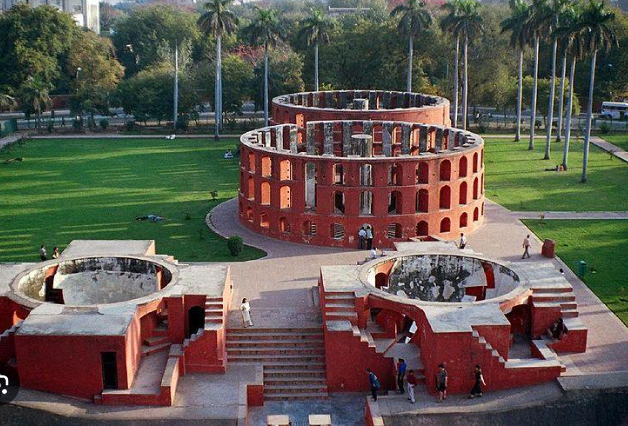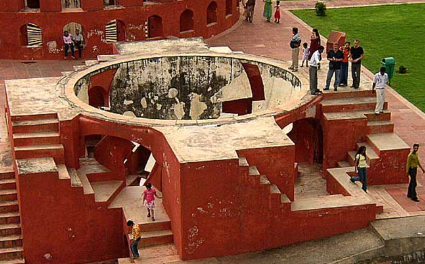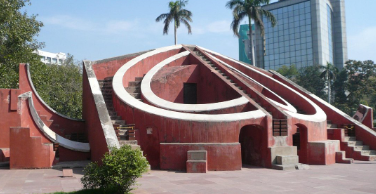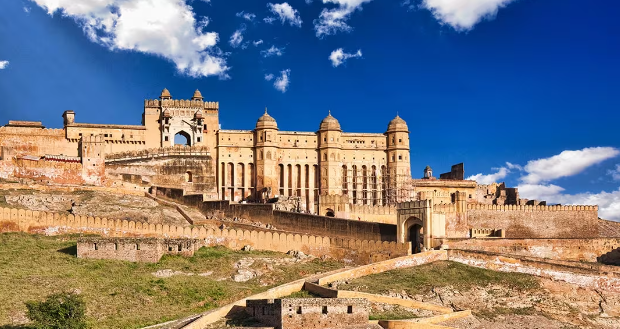Jantar Mantar – Delhi
Jantar Mantar is situated in the contemporary city of New Delhi. Tickets, Timings & History

About Jantar Mantar
Jantar Mantar is situated in the contemporary city of New Delhi. The term “Jantar Mantar” translates to “instruments for measuring the harmony of the heavens.” This site features 13 architectural instruments dedicated to astronomy. It is one of five such observatories established by Maharaja Jai Singh II of Jaipur, beginning in 1723, with the aim of revising the calendar and astronomical tables. Born in 1688 into a royal Rajput lineage that governed the regional kingdom, Jai Singh lived during a period that fostered a strong interest in education and astronomy. A plaque affixed to one of the structures at the Jantar Mantar observatory in New Delhi erroneously dates the complex’s construction to 1710; however, subsequent research indicates that it was actually completed in 1724. The observatory reaches a height of 723 feet (220 m).
The main objective of the observatory was to compile astronomical tables and to forecast the timings and movements of celestial bodies such as the sun, moon, and planets. Many of these functions would now be categorized under the field of astronomy.
By the time of the 1857 uprising, the Delhi Jantar Mantar had significantly deteriorated. The observatory houses several notable instruments, including the Ram Yantra, the Samrat Yantra, the Jai Prakash Yantra, and the Misra Yantra. The most renowned of these, located in Jaipur, also fell into disrepair by the late nineteenth century until Maharaja Ram Singh initiated restoration efforts in 1901.
Read Also: Red Fort facts
History – Jantar Mantar

Jantar Mantar, situated in New Delhi, was constructed by Maharaja Jai Singh II of Jaipur in 1724. During his reign in the 18th century, the maharaja established five observatories, with the one in Delhi being the first among them. The remaining four observatories can be found in Ujjain, Mathura, Varanasi, and Jaipur.
The primary purpose of these observatories was to collect astronomical data and to make precise predictions regarding the movements of celestial bodies such as planets, the moon, and the sun within the solar system. At the time of its construction, it was a unique establishment. However, by 1867, during the period of British rule in India, the observatory had experienced significant deterioration.
Structure : Jantar Mantar

1. Samrat Yantra: The Samrat Yantra, also known as the Supreme Instrument, is an enormous triangular structure that functions as an equal hour sundial. Standing at 70 feet in height, with a base measuring 114 feet in length and a thickness of 10 feet, it features a hypotenuse of 128 feet (39 meters) that aligns parallel to the Earth’s axis, directing towards the North Pole. Flanking the triangle are quadrants marked with graduations for hours, minutes, and seconds. Although sundials were already in existence at the time of the Samrat Yantra’s creation, this particular instrument transformed the conventional sundial into a precise device for measuring declination and other related coordinates of celestial bodies. The Vrihat Samrat Yantra is capable of determining local time with an accuracy of up to two seconds, earning it the title of the largest sundial in the world.
2. Jaya Prakash Yantra: The Jaya Prakash Yantra comprises hollow hemispheres featuring markings on their concave surfaces, with crosswires extended between points along their rims. Observers positioned within the structure can align the location of a star with various markings or the edge of a window. This instrument is recognized for its versatility and complexity, providing the coordinates of celestial objects across multiple systems, including the Azimuthal-altitude system and the Equatorial coordinate system. This capability facilitated the straightforward conversion of the widely used celestial system.
3. Rama Yantra: The Rama Yantra consists of two large cylindrical structures that are open at the top, designed to measure the altitude of stars based on the Earth’s latitude and longitude.
4. Misra Yantra: The Misra Yantra, which translates to “mixed instrument,” is a combination of five instruments crafted to ascertain the shortest and longest days of the year. It is also capable of indicating the precise moment of noon in various cities and locations, irrespective of their distance from Delhi. The Misra Yantra uniquely allows for the determination of noon across different cities worldwide and is notable for being the only structure in the observatory not conceived by Jai Singh II.
5. Shasthansa Yantra: Utilizing a pinhole camera mechanism, the Shasthansa Yantra has been constructed within the towers that support its function.

Entry Tickets : Jantar Mantar
- ₹25 per person for Indians
- ₹300 per person for Foreign Tourists
- ₹25 per person for SAARC Visitors
- ₹25 per person for BIMSTEC Visitors
- ₹0 per person for Photography
- ₹25 per person for Video filming
Timings: Jantar Mantar

Share this content:














1 comment